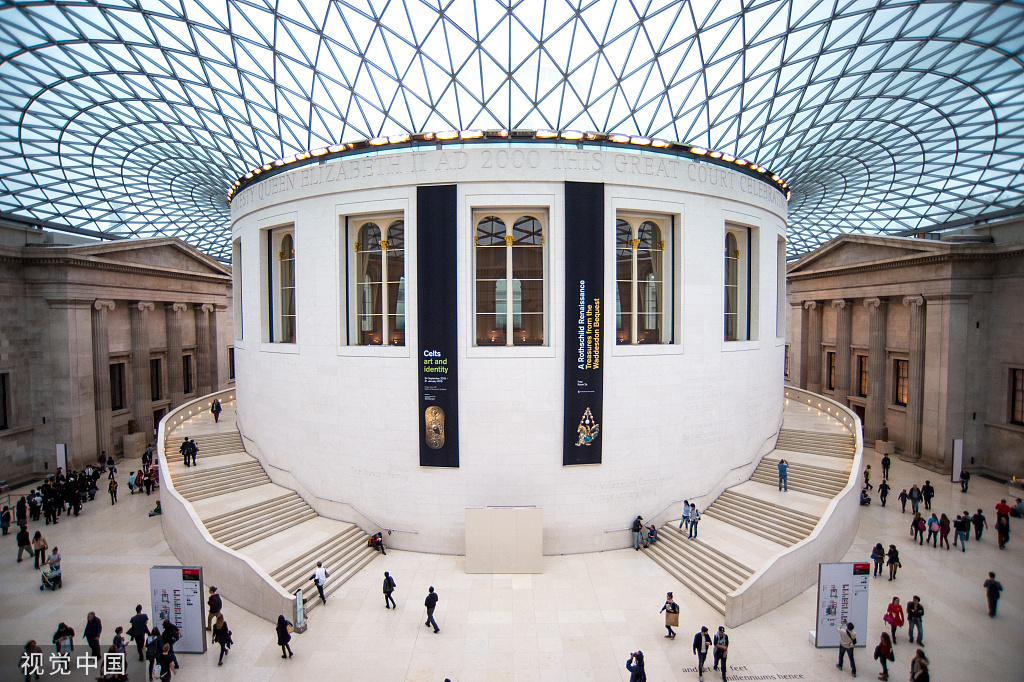History of the British Museum
Author:Global Times Time:2022.08.22
[Global Times Special Journalist Ji Shuangcheng in the UK] The British Museum established in the 18th century. In the past three centuries, the number of visitors has received more than 350 million visitors. As the world's first national public museum, the British Museum collects civilized memories of the world, but its development is closely related to war and colonial history.

British Museum Tap Source Vision China
In 1753, the British collector Hans Son died. Before bidding people, he made a will and donated countless treasures collected from all over the world to the country. These treasures subsequently became the foundation of the British Museum. On June 7, 1753, King George II of the United Kingdom approved the establishment of the British Museum. Subsequently, the British Museum came out of the Montegu Mansion in London.
After accumulation, there are more and more collections of the British Museum, which is closely related to British colonial expansion policies at the time. In 1763, Britain defeated France to become the world's ocean hegemony through the seven -year war; in 1815, Britain won the Napoleonic War and became the world's first power at that time. The story that happened in the Muse Temple and the Louvre, which happened again in the Great British Museum. As British colonial footprints spread throughout the world, the treasures of civilizations in various countries have gradually flowed into the British homeland through various forms, and eventually displayed in the British Museum.
Among them, the most famous is about the Rosetta stele. In 1799, Egypt was in a short period of Napoleon, and the Rosetta monument was discovered by a French captain. In 1801, the French who lost to the British army stole Rosetta stone monuments to attempted to return to China. The stele fell into the hands of the British army and was finally displayed in the Egyptian Pavilion of the British Museum. The largest and lasting dispute is the stone carvings of the Paton Temple. At the end of the 18th century, the British diplomat Erkin bought a large number of Greek Patonon Temple stone carvings through various means, and was transported back to the UK after cutting. These marble carvings were eventually sold to the British Museum. Over the years, Greece has shouted many times and asked the United Kingdom to return the sculpture of Paton Temple.
In order to provide more space for the increasing collections in the museum, in the 1880s, the natural historical collections in the British Museum were transferred to the new building in the South Kenton District of London, and later became the Museum of Natural History.
In the 19th century, with the continuous development of academic research, managers improved the attractiveness of museums by setting up lectures, improving exhibition methods, and methods such as prefabrication on collections.
In the 20th century, the public services of the British Museum developed a lot. Published the first museum guide in 1903, and appointed the first interpreter in 1911. By the 1970s, the British Museum renovated its art museum and established educational service agencies and publishers. In the early 21st century, the museum continued to expand public buildings.
As a world -class comprehensive museum, the extremely rich collection of the British Museum itself is a huge treasure house for research. Therefore, another difference from ordinary museums is that the British Museum is still a research institution. Not only did scholars from all over the world work here, but the museum also has its own journals.
However, the British Museum is currently facing many controversy, and its unsuccessful attitude in returning cultural relics has repeatedly recruited criticism. Faced with the protests of the source of the cultural relics and activities, the British Museum responded: "If each piece of cultural relics will return to its original geographical location, including the British Museum, all the great museums in the world will be hollowed out. "
- END -
Meet the colorful you in Inner Mongolia

JPEG Webkit-Playsinline Green is a vibrant and uniqueness; golden is fruitful, a...
Why "Ma Steel Feiyan" is "flying into the home of ordinary people"
【Cultural Evaluation】Recently, the Gansu Provincial Museum launched a Ma Steel Feiyan plush dolls, which is greatly sought after by the market, and has quickly become a social and cultural topic.